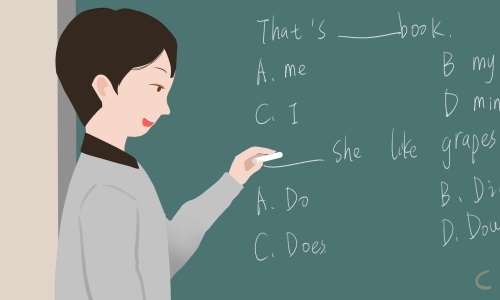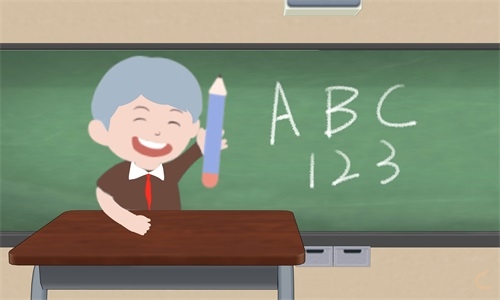情态动词有具体的词义,但也同助动词一样,需要与其他词语一起构成句子的谓语,另外情态动词没有人称和数的变化,情态动词后必须跟动词原形。那么接下来给大家分享一些关于英语情态动词用法归纳,希望对大家有所帮助。
英语情态动词用法归纳
1. can 的用法:
(1).表示能力、许可、可能性。 表示能力时一般译为“能、会”, 即有种能力,尤其是生来具备的能力,此时may 和must均不可代替它。如:She can swim fast, but I can’t . 她能游得很快,但我不能。I can see with my eyes. 我用眼睛看。
(2).表示许可,常在口语中。如:You can use my dictionary. 你可以用我的字典。
(3).表示推测,意为“可能”, 常用于否定句和疑问句中, 此时can’t 译为“ 不可能”。 如:Can the news be true? 这个消息会是真的吗?—Can it be our teacher?那个人有可能是我们老师吗?—No, it can’t be our teacher. He is on a visit to the Great Wall.不可能。咱们老师正在游览长城呢。
【例题】—I think Miss Gao must be in the library. She said she would go there. —No. She __be there, I have just been there. A.can’t B.mustn’t C.needn’t D.wouldn’t
【解析】根据下文“我刚去过那儿”可知,应为“ 不可能”, can’t 表示推测[答案] A
2. could的用法:
(1).can的过去式,意为“ 能、 会”,表示过去的能力。如:He could write poems when he was 10. 他十岁时就会写诗。
(2). could在疑问句中,表示委婉的语气,此时 could 没有过去式的意思。如:Could you do me a favour? 你能帮我个忙吗?—Could I use your pen? 我能用一下你的钢笔吗? —Yes, you can.可以。(注意回答)
3. may的用法:
(1).表示请求、许可,比can 正式,如:May I borrow your bike? 我可以借你的自行车吗?You may go home now. 现在你可以回家了。
【例题】—_______ I borrow your MP3? —Sure . Here you are. A. May B.Should C.Must D. Would
【解析】 在此处表示请求,意为“ 做……可以吗”。 答案:A
(2) .表示推测,谈论可能性,意为“ 可能, 或许”,一般用于肯定句中。 如:It may rain tomorrow . 明天可能会下雨。She may be at home. 她可能在家呢.
(3) .may的过去式为might ,表示推测时。可能性低于may。 如:He is away from school. He might be sick.
他离开学校了,可能是他生病了。
(4) . 表示希望、祈求、祝愿,常可译为“祝愿”。通常是用may +主+V 例如:May you have a good time. 祝你过得愉快。May you be happy! 祝你幸福! May you succeed!祝你成功!
4. must的用法:
(1).must 表示主观看法,意为“必须、一定”。 如:You must stay here until I come back.在我回来之前你必须呆在这儿。Must I hand in my homework right now? 我必须现在交作业吗?
(2) 其否定形式mustn’t表示“ 一定不要 ” “千万别” “禁止, 不许”. 如:You mustn’t play with fire. 你不许玩火。You mustn’t be late. 你一定不要迟到。
(3)对must引导的疑问句,肯定回答为must,否定回答为needn’t 或 don’t have to .如:—Must I finish my homework?我现在必须完成作业吗?—No, you needn’t.不,你不必。
(4)must表示有把握的推测,用于肯定句。如: The light is on, so he must be at home now.灯亮着,他现在肯定在家。
注意其反意问句的构成形式:
当must表示肯定的判断、推测时,其反意疑问句要用实际问句的助动词来构成。如:She must have seen the film before,hasn’t she?(注意反意疑问句的后半部分)You must have met uncle Wang in the shop yesterday,didn’t you? (注意反意疑问句的后半部分)
5. need的用法:
(1).need 表示需要、必须,主要用于否定句和疑问句中,其否定形式为needn’t,意为“没有必要,不必”。 用need 提问时,肯定回答为 must,否定回答为 needn’t或don’t have to。 如:—Need I stay here any longer? 我还有必要留在这儿吗?—Yes, you must .是的。—No. you needn’t /don’t have to. 不, 你不必。
(2).need 还可以作实义动词,此时有人称、数和时态的变化,如果是人作主语后边多接动词不定式。如:I need to do it right now. 我需要马上做这件事。He needs to learn more about the girl.他需要多了解那个女孩。
如果是物作主语,一般用need doing 与 need to be done这种情况下应注意两点:
①.主动形式的动名词doing具有被动的含义;②.该动名词可以改为其动词不定式的被动形式而句子的意义不变。例如:. The door needs painting. = The door needs to be painted. 那扇门需要油漆一下。Your car needs mending. = Your car needs to be repaired. 你的车需要维修了。
6. dare 的用法:dare意为“敢、敢于”, 用法近似于need,有两种词性:
(1)dare 作为情态动词,多用于否定句、疑问句或条件句中,无第三人称单数形式,只有一般现在时和一般过去时。如:Dare he tell them what he knows? 他敢告诉他们所知道的情况吗?I daren’t ask her – will you do it for me? 我可不敢问她,你能帮我问问吗?
(2)dare 作为实义动词,此时有人称、数及时态的变化。如:He doesn’t dare to break his promise.他不敢食言。
注意:在口语中,dare 的各种形式常与不带to 的不定式连用。如:Do you dare tell her what I said?
你敢告诉她我说的话吗?I didn’t dare look at him.我不敢看他。
英语情态动词讲解:
一、九大情态动词的时态关系:
1. 现在式 can -- 过去式 could
2. 现在式 may -- 过去式 might
3. 现在式 shall -- 过去式 should
4. 现在式 will -- 过去式 would
5. 现在式 must -- 过去式 must (常用had to来代替)
二、情态动词表示“可能”或“预测”
(can, could, will, would, shall, should, must, ought to)
(1)can 和 could 用于表示“可能”或“预测”:
1. He can't be at home. 他不可能在家。(否定句)
2. Can the news be true? 这消息可能是真的吗? (将情态动词 can 置于主语 the news 前就成疑问句)
3. Anybody can make mistake. 任何人都可能犯错误。(只表示理论上的可能性)
(2)may 和 might 用于表示“事实上的可能性”或“预测”:
1. It may rain tomorrow. (表示可能会发生) 明天可能会下雨。
2. It may snow later this afternoon. (表示预测) 今天下午可能会下雪。
3. You might be right. (表示有可能) 你可能是对的。
(3)will 和 would 用于表示“预测”或“习惯性”:
1. I think he will be all right now. 我想他现在一定好了。 (will be 表示一定会)
2. That would be his mother. 那肯定是他母亲。(would be 表示肯定是)
3. He will sit there hour after hour looking at the river.
他经常一连几个小时坐在那儿看着河水。(will 表示经常的)
(4)shall 和 should 用于表示“必定”:
1. I shall be rich one day. (shall be ) 总有一天我会发达的。
2. That should be Sam and his mother. (should be)那准是Sam和他的母亲。
(5)must 用于表示“必定”,“必会”:
1. This must be good for you.(must be 肯定) 这肯定对你是有益的。
2. All mankind must die.(表示必然会发生的事) 所有的人一定会死的。
3. Mustn't there be a mistake? (mustn't 多用于疑问句) 那肯定会有错误吗?
三、情态动词表示“许可”、“请求”
(can, could, will, would, shall, should, may, might, must)
(1)can 和 could 用于表示“许可”、“请求”:
1. Can I go with you? (请求)我能跟你一起走吗?
2. Father said I could go to cinema. (表示过去的许可) 爸爸说我可以去看电影。
3. Could I ask you something? (请求,用 could 比 can 更婉转)我可以问你一件事吗?
(2)will 和 would 用于表示“请求”
1. Will you kindly tell me the way to the post office? 请问到邮局怎么走?(表示客气请求)
2. Would you give me your address? 请你告诉我你的地址,好吗?(用would比will表示更客气)
(3)shall 和 should 用于第一人称,表示征求对方的意见
1. Shall we talk? 我们谈谈好吗?
2. What should we do next? (用should 比 shall 表示更客气) 下一步我们该怎么做?
3. Shall he come to see you? (用于第三人称疑问句) 要不要他来看你?
(4)may 和 might 用于表示“许可”(口语中多用can)
1. You may take a walk. (表示给予许可) 你可以散散步。
2. You might read the story for me. (比may更婉转) 是否请给我读一读这故事。
3. May I make a suggestion? 我可以提个建议吗?
4. Might I take a look of your work? 我看看您的大作行吗?
5. Students may not make noise in the library. (may not 表示不许可或禁止)
学生不得在图书馆里吵闹。
6. If I may say so, you are not right. (用于条件句,表示请求)
你是不对的,如果我可以这么说的话。
(5)must 用于表示“禁止”,“不准”:
1. Cars must not be parked here. (must not表示不许可) 此地不准停车。
2. All of you mustn't fishing in the pool. (must not 语气方面比 may not 更强)
你们不准在池里钓鱼。
情态动词用法归纳:
一、 can, could
1) 表示能力(体力、知识、技能)。
Can you lift this heavy box?(体力)
Mary can speak three languages.(知识)
Can you skate?(技能)
此时可用be able to代替。Can只有一般现在时和一般过去式;而be able to则有更多的时态。
I’ll not be able to come this afternoon.
当表示“经过努力才得以做成功某事”时应用be able to,不能用Can。如:
He was able to go to the party yesterday evening in spite of the heavy rain.
2) 表示请求和允许。
-----Can I go now?
----- Yes, you can. / No, you can’t.
此时可与may互换。在疑问句中还可用could,
might代替,不是过去式,只是语气更委婉,不能用于肯定句和答语中。
---- Could I come to see you tomorrow?
---- Yes, you can. ( No, I’m afraid not. )
3) 表示客观可能性(客观原因形成的能力)。
They’ve changed the timetable, so we can go by bus instead.
This hall can hold 500 people at least.
4) 表示推测(惊讶、怀疑、不相信的态度),用于疑问句、否定句和感叹句中。
Can this be true?
This can’t be done by him.
How can this be true?
二、 may, might
1) 表示请求和允许。might比 may语气更委婉,而不是过去式。否定回答时可用can’t
或mustn’t,表示“不可以,禁止”。
----Might/ May I smoke in this room?
---- No, you mustn’t.
---- May/Might I take this book out of the room?
---- Yes, you can. (No, you can’t / mustn’t. )
用May I...?征徇对方许可时比较正式和客气,而用Can I...?在口语中更常见。
2)用于祈使句,表示祝愿。
May you succeed!
3) 表示推测、可能性(不用于疑问句)。
might不是过去式,它所表示的可能性比may小。
1.He may /might be very busy now.
2.Your mother may /might not know the truth.
三、 must, have to
1) 表示必须、必要。
You must come in time.
在回答引出的问句时,如果是否定的,不能用mustn’t(禁止,不准),而用needn’t, don’t have to(不必).
---- Must we hand in our exercise books today?
---- Yes, you must.
---- No, you don’t have to / you needn’t.
2) must是说话人的主观看法, 而have to则强调客观需要。Must只有一般现在时, have to 有更多的时态形式。
1. he play isn’t interesting, I really must go now.
2. I had to work when I was your age.
3) 表示推测、可能性(只用于肯定的陈述句)
1. You’re Tom’s good friend, so you must know what he likes best.
2. Your mother must be waiting for you now.
四、 dare, need
1) dare作情态动词用时, 常用于疑问句、否定句和条件从句中, 过去式形式为dared。
1. How dare you say I’m unfair?
2. He daren’t speak English before such a crowd, dare he?
3. If we dared not go there that day, we couldn’t get the beautiful flowers.
2) need 作情态动词用时, 常用于疑问句、否定句。在肯定句中一般用must, have to, ought to, should代替。
1.You needn’t come so early.
2. ---- Need I finish the work today?
---- Yes, you must. / No, you needn’t.
3) dare和 need作实义动词用时, 有人称、时态和数的变化。在肯定句中,dare后面常接带to的不定式。在疑问句和否定句中,dare后面可接带to或不带to的不定式。而need后面只能接带to的不定式。
1. I dare to swim across this river.
2. He doesn’t dare (to) answer.
3. He needs to finish his homework today.
英语情态动词用法归纳相关文章:
★ 高考英语情态动词语法知识点与用法
★ 2020高三英语语法情态动词整理归纳
★ 情态动词英语语法知识点汇总
★ 初中英语情态动词之shall和should的正确用法
★ 高考英语情态动词用法与书面表达范例
★ 英语语法掌握情态动词
★ 英语中情态动词may, might的用法
★ 英语语法网情态动词讲解
★ 英语作文之情态动词
英语情态动词用法归纳
上一篇:英语的朗读技巧有哪些
下一篇:返回列表






